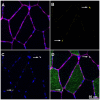Fiber Type-Specific Satellite Cell Content in Cyclists Following Heavy Training with Carbohydrate and Carbohydrate-Protein Supplementation
- PMID: 27899900
- PMCID: PMC5110549
- DOI: 10.3389/fphys.2016.00550
Fiber Type-Specific Satellite Cell Content in Cyclists Following Heavy Training with Carbohydrate and Carbohydrate-Protein Supplementation
Abstract
The central purpose of this study was to evaluate the fiber type-specific satellite cell and myonuclear responses of endurance-trained cyclists to a block of intensified training, when supplementing with carbohydrate (CHO) vs. carbohydrate-protein (PRO). In a crossover design, endurance-trained cyclists (n = 8) performed two consecutive training periods, once supplementing with CHO (de facto "control" condition) and the other with PRO. Each training period consisted of 10 days of intensified cycle training (ICT-120% increase in average training duration) followed by 10 days of recovery (RVT-reduced volume training; 33% volume reduction vs. normal training). Skeletal muscle biopsies were obtained from the vastus lateralis before and after ICT and again following RVT. Immunofluorescent microscopy was used to quantify SCs (Pax7+), myonuclei (DAPI+), and myosin heavy chain I (MyHC I). Data are expressed as percent change ± 90% confidence limits. The 10-day block of ICTCHO increased MyHC I SC content (35 ± 28%) and myonuclear density (16 ± 6%), which remained elevated following RVTCHO (SC = 69 ± 50% vs. PRE; Nuclei = 17 ± 15% vs. PRE). MyHC II SC and myonuclei were not different following ICTCHO, but were higher following RVTCHO (SC = +33 ± 31% vs. PRE; Nuclei = 15 ± 14% vs. PRE), indicating a delayed response compared to MyHC I fibers. The MyHC I SC pool increased following ICTPRO (37 ± 37%), but without a concomitant increase in myonuclei. There were no changes in MyHC II SC or myonuclei following ICTPRO. Collectively, these trained endurance cyclists possessed a relatively large pool of SCs that facilitated rapid (MyHC I) and delayed (MyHC II) satellite cell proliferation and myonuclear accretion under carbohydrate conditions. The current findings strengthen the growing body of evidence demonstrating alterations in satellite cell number in the absence of hypertrophy. Satellite cell pool expansion is typically viewed as an advantageous response to exercise. However, when coupled with our previous report that PRO possibly enhanced whole muscle recovery and increased MyHC I and II fiber size, the limited satellite cell/myonuclear response observed with carbohydrate-protein seem to indicate that protein supplementation may have minimized the necessity for satellite cell involvement, thereby suggesting that protein may benefit skeletal muscle during periods of heavy training.
Keywords: endurance-trained cyclists; intensified training; myogenesis; protein supplementation.
Figures


Similar articles
-
Resistance exercise training promotes fiber type-specific myonuclear adaptations in older adults.J Appl Physiol (1985). 2020 Apr 1;128(4):795-804. doi: 10.1152/japplphysiol.00723.2019. Epub 2020 Mar 5. J Appl Physiol (1985). 2020. PMID: 32134710 Free PMC article.
-
Satellite cell and myonuclear accretion is related to training-induced skeletal muscle fiber hypertrophy in young males and females.J Appl Physiol (1985). 2021 Sep 1;131(3):871-880. doi: 10.1152/japplphysiol.00424.2021. Epub 2021 Jul 15. J Appl Physiol (1985). 2021. PMID: 34264129
-
Fibre type-specific satellite cell response to aerobic training in sedentary adults.J Physiol. 2014 Jun 15;592(12):2625-35. doi: 10.1113/jphysiol.2014.271288. Epub 2014 Mar 31. J Physiol. 2014. PMID: 24687582 Free PMC article. Clinical Trial.
-
Muscle Fiber Hypertrophy and Myonuclei Addition: A Systematic Review and Meta-analysis.Med Sci Sports Exerc. 2018 Jul;50(7):1385-1393. doi: 10.1249/MSS.0000000000001593. Med Sci Sports Exerc. 2018. PMID: 29509639
-
The impact of sarcopenia and exercise training on skeletal muscle satellite cells.Ageing Res Rev. 2009 Oct;8(4):328-38. doi: 10.1016/j.arr.2009.05.003. Epub 2009 May 21. Ageing Res Rev. 2009. PMID: 19464390 Review.
Cited by
-
Muscle memory: myonuclear accretion, maintenance, morphology, and miRNA levels with training and detraining in adult mice.J Cachexia Sarcopenia Muscle. 2020 Dec;11(6):1705-1722. doi: 10.1002/jcsm.12617. Epub 2020 Sep 2. J Cachexia Sarcopenia Muscle. 2020. PMID: 32881361 Free PMC article.
-
Starring or Supporting Role? Satellite Cells and Skeletal Muscle Fiber Size Regulation.Physiology (Bethesda). 2018 Jan 1;33(1):26-38. doi: 10.1152/physiol.00019.2017. Physiology (Bethesda). 2018. PMID: 29212890 Free PMC article. Review.
-
Nutritional Regulation of Muscle Stem Cells in Exercise and Disease: The Role of Protein and Amino Acid Dietary Supplementation.Front Physiol. 2022 Jul 7;13:915390. doi: 10.3389/fphys.2022.915390. eCollection 2022. Front Physiol. 2022. PMID: 35874517 Free PMC article. Review.
-
Myonuclear Domain Flexibility Challenges Rigid Assumptions on Satellite Cell Contribution to Skeletal Muscle Fiber Hypertrophy.Front Physiol. 2018 May 29;9:635. doi: 10.3389/fphys.2018.00635. eCollection 2018. Front Physiol. 2018. PMID: 29896117 Free PMC article.
-
Protein Availability and Satellite Cell Dynamics in Skeletal Muscle.Sports Med. 2018 Jun;48(6):1329-1343. doi: 10.1007/s40279-018-0883-7. Sports Med. 2018. PMID: 29557519 Review.
References
LinkOut - more resources
Full Text Sources
Other Literature Sources

